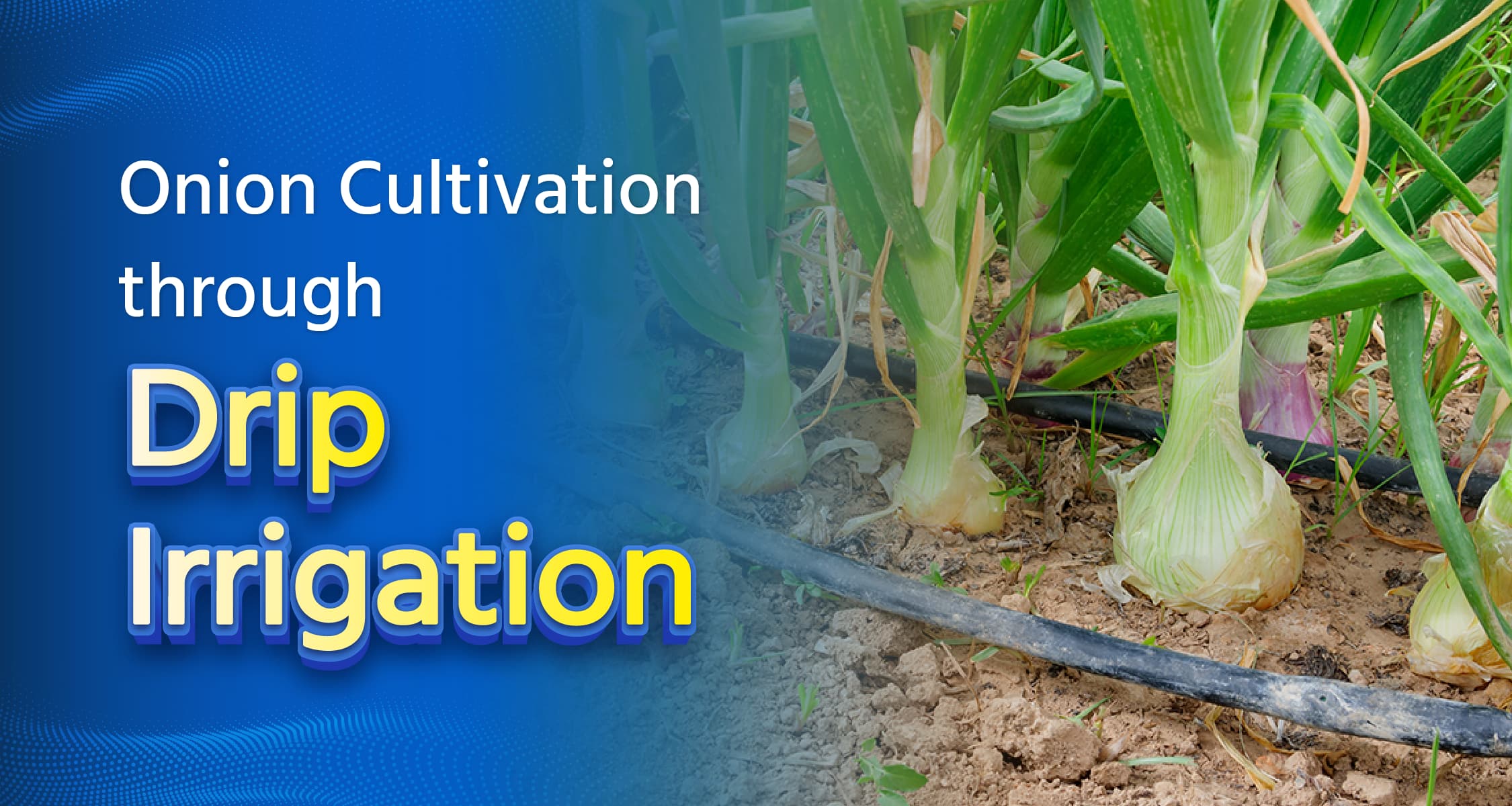Onion Cultivation through Drip Irrigation

In most parts of India, onion farming is traditionally done using conventional irrigation methods. However, in recent times, some regions have seen farmers adopting modern techniques for onion cultivation to achieve higher yields. One of the key techniques is drip irrigation, also known as trickle irrigation or micro-irrigation. Drip irrigation is a method where water is delivered slowly and directly to the plant roots, conserving water and enhancing crop productivity. In this article, we will explore the use of drip irrigation in onion farming, its benefits, and the detailed process involved.
Drip Irrigation in Onion Farming
Onion is a crop that requires consistent moisture levels. Both overwatering and underwatering can negatively affect the quality and yield of onions. Traditional irrigation methods lead to higher water consumption and make irrigation management difficult. Drip irrigation provides a solution to these issues by delivering water directly to the roots of the plants as needed. Additionally, drip irrigation allows for efficient fertilizer management as well.
Importance of Drip Irrigation for Onion Farming
Water Conservation
- Proper irrigation management is crucial in onion farming. Through drip irrigation, water savings of 30-50% can be achieved. Water is delivered directly to the roots, preventing wastage in other parts of the field.
Effective Fertilizer Utilization
- In drip irrigation, fertilizers can be mixed with water and delivered directly to the roots, ensuring maximum fertilizer utilization. This improves crop quality and increases yield.
Saves Time and Labor
- Drip irrigation helps farmers save time and labor in watering. The pipeline system and drip method make it easy to distribute water evenly across the entire field.
Increase in Yield
- Drip irrigation provides a consistent supply of moisture to onion crops, promoting better root development. This results in improved size and quality of the onions, with a yield increase of 20-30%.
Disease and Pest Control
- Drip irrigation supplies water as needed, maintaining soil balance and preventing excess moisture that can lead to fungal diseases. Additionally, pesticides can be applied through the drip system, reducing pest-related damage.
How to Cultivate Onions Using the Drip Irrigation Method?
Suitable Soil and Climate
- The ideal temperature for onion cultivation ranges from 13 to 25°C. Onions can be grown in almost all types of soil, but for better yields, choose loamy or clay soils rich in organic matter. The soil pH should be between 6 and 7.5.
Sowing Time and Seed Quantity
- For the Rabi season, sow the seeds in October-November.
- For the Kharif season, sowing is done in May-June.
- For harvesting onions in the summer, sow the seeds in January-February.
- You will need 1.5 to 2 kilograms of seeds per acre of land.
Field Preparation
- First, perform a deep plowing once. After that, plow 2-3 times lightly to make the soil loose. Simultaneously, level the field for planting the seedlings. For drip irrigation, transplant the seedlings at an interval of 4 x 6 inches, on beds that are 6 inches high and 47 inches wide. Each bed should have two drip laterals of 16 millimeters in size, placed 24 inches apart with inbuilt emitters. The water flow rate should be 4 liters per hour.
Irrigation System
- In the drip irrigation method, pipelines and emitters (drip nozzles) are used. Arrange the pipeline according to the size of the field so that every onion plant receives water. Place the emitters near the plant roots to ensure direct water delivery to the roots.
Fertilizer Management
- As a basal dose, apply 22 kg of urea, 35 kg of DAP (Di-ammonium Phosphate), 40 kg of Muriate of Potash, and 8 kg of sulfur per acre. From transplanting in the main field until 60 days after transplanting, apply 60 kg of urea mixed with water through drip irrigation in 7 doses at weekly intervals.
Irrigation Management
- Under drip irrigation, onion plants are provided with appropriate amounts of water at different stages of growth. Water is supplied in smaller quantities during sowing and the early stages of growth, but as the plants grow and bulbs form, the water supply is increased. It's important to ensure that over-irrigation is avoided, as it can lead to fungal infections in the onion bulbs.
Weed Control
- For effective weed control, carry out hand weeding as needed. Mulching in the field can also help reduce the problem of weeds. If weeds still persist despite these efforts, use appropriate herbicides as recommended by agricultural experts.
Disease and Pest Control
- Onion crops are prone to diseases and pests such as damping-off, blight, purple blotch, wilt, thrips, aphids, whiteflies, and red spider mites. Regular inspection of the field is essential to detect these diseases and pests early, allowing for timely control and prevention.
Harvesting the Crop
- The time required for onion crops to mature varies depending on the variety and the season. Some varieties take around 100-120 days to mature, while early-maturing varieties can be harvested in 70-80 days. During the Rabi season, harvest the crop when approximately 50% of the onion leaves fall near the ground. In the Kharif season, onions should be harvested when the leaves turn yellowish-red.
Have you ever used drip irrigation in onion farming? Share your answers and experiences with us in the comments. For more such information, follow the 'Krishi Gyan' channel now. And don’t forget to like and share this post!
Frequently Asked Questions (FAQs)
Q: How much does drip irrigation cost per acre?
A: The cost of drip irrigation can vary depending on factors such as the type of crop, soil type, water quality, and the type of drip irrigation system used. On average, the cost of drip irrigation for 1 acre of land can range from ₹50,000 to ₹1,00,000 or more. This includes the cost of drip tape, filters, valves, pressure regulators, and other equipment required for the drip irrigation system.
Q: What is the difference between drip irrigation and sprinkler irrigation?
A: Drip irrigation and sprinkler irrigation are two common methods of watering crops. In drip irrigation, water is delivered drop by drop directly to the plant roots using pipes and nozzles. In sprinkler irrigation, water is sprayed over a large area using pipes and sprinklers.
Q: How is drip irrigation beneficial?
A: Drip irrigation is a modern irrigation system that offers several benefits. It helps save water during irrigation. Water-soluble fertilizers, herbicides, fungicides, and pesticides can be applied along with irrigation. It reduces labor costs and saves time. Drip irrigation also helps prevent weed growth, and improves crop yield and quality.
Please login to continue

Get free advice from a crop doctor
